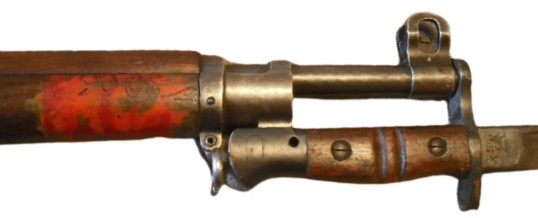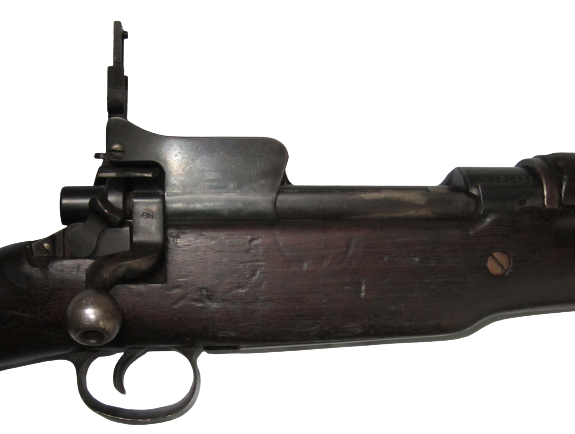The Pattern 1913 Enfield (P13) rifle was developed as a potential replacement for the Short Magazine Lee-Enfield (SMLE) rifle that entered service in 1902. At a time when long range shooting was considered important for a service rifle, the accuracy of the SMLE was an issue due to the use of rear locking lugs on the bolt. This resulted in the firing forces being transferred through the body of the receiver that could then flex in principle affecting the accuracy of the rifle.
In the P13 experimental rifle, front locking lugs were therefore employed and a new .276 high powdered bottle-necked, rimless cartridge was developed. This gave a muzzle velocity of 2785 fps compared with the 2440 fps for the SMLE. After further experimentation with the cartridge design, a limited number of P13 rifles were produced at the Royal Small Arms Factory (RSAF) Enfield in 1913 for troop trials. However, when the First World War broke out, the development of the rifle using the .276 experimental cartridge was shelved.

Since huge numbers of small arms were needed in the early years of WW1 and industrial capacity was stretched, the decision was taken to convert the P13 to .303 calibre and to manufacture it in the USA. The .303 version was designated the Pattern 1914 rifle. It was principally made by Winchester, Remington and Eddystone and the serial number for the rifles includes either a ‘W’ for Winchester, an ‘R’ for Remington or an ‘E’ for Eddystone. The .303 Rifle P14 Mk I was accepted into service in 1916 and, in total, more than 1 million were manufactured in the USA. However, later that year, the lugs on the bolt were enlarged slightly to produce the Mk I* pattern.
After WW1 had settled into trench warfare, the need for a good sniper rifle for the British Army became apparent. Initially, selected SMLE’s were used that were fitted with a telescopic sight that was offset to the left of the action body. However, this created obvious zeroing problems for the rifle and also made it difficult to use from behind cover.
The P14 was found to be a much more accurate sniper rifle. Initially, rifles made by Winchester were fitted with a fine adjustment rear ladder sight for sniping, designated the P14 Mk I* W(F). An Aldis telescopic sight was later fitted to produce the P14 Mk I* W(T) and, in contrast to the SMLE sniper rifle, this was mounted along the centre line above the breech. Although this meant that the magazine could not be loaded via stripper clips, loading single rounds by hand was not considered an issue for a sniper rifle.

In the meantime, when the US entered the WW1 conflict they also required a huge increase in the number of small arms. Although they considered converting the P14 US manufacturing facilities to produce the Springfield Model 1903, it was decided that it would be simpler to manufacture the P14 instead, modified to fire the standard 30-06 round. This rifle became the Model 1917 Enfield and, during WW1, it equipped more US troops than the Springfield Model 1903.
At the outbreak of WW2 following the Dunkirk evacuation, small arms were in short supply and therefore the available stock of stored P14 rifles was issued to Home Guard units. However, since 1926, the designation had changed and, by WW2, the rifle was officially known as the No. 3 Mk I rifle. In addition, surplus stocks of US M1917 Enfield rifles were acquired under Lend Lease and these were also issued to Home Guard units. However, since these fired the US 30-60 round, the rifles were marked with a wide red band around the stock to avoid confusion with .303 rifles.

Pattern 1914 Mk I Design
The P14 used a Mauser like bolt with two forward locking lugs and a non-rotating claw extractor. One significant difference when compared with the contemporary Gew 98 Mauser rifle was the absence of the third locking lug on the bolt which Paul Mauser had introduced for safety reasons in the event that the forward locking lugs failed. In the case of the P14, this safety measure was achieved by using the bent bolt handle for this purpose which engaged in a slot in the receiver when closed.
Another difference with the Gew98 was that the forward lugs on there P14 were designed to provide a helical locking surface – in other words, the bolt closed via what was effectively an interrupted thread. This ensured positive closing of the breech when the bolt was turned down making the process much less sensitive to variations in the quality of the ammunition. The rear of the bolt also incorporated a cam surface that acted against a lug in the receiver to provide initial extraction of the cartridge as the bolt was opened. The bolt was fitted with the original, pre Gew 98, type trigger/sear/interlock that prevents the sear from being moved by the trigger until the bolt is fully closed.
The SMLE bolt action and box magazine fortuitously placed the bolt handle just behind the trigger which was the ideal location for efficient operation of the bolt. This was coupled with only 60 degrees of rotation required to unlock the bolt and the fact that it cocked on closing both of which allowed very easy and rapid cycling of the bolt in action and therefore rapid fire.
Unfortunately, the use of a Mauser like internal magazine requires a significantly greater distance between the trigger and the end of the breech which, in turn, moves the bolt handle some distance in front of the trigger. The P14 bolt used the same 60 degrees rotation and cock-on-closing as the SMLE but, to put the bolt handle behind the trigger to allow rapid cycling of the bolt, the P14 bolt handle was therefore given a distinctive dog-leg shape. In contrast with other Mauser like rifles that have the safety on the end of the bolt, the P14 positioned the safety lever on the right-hand side on the receiver just behind the bolt. The P14 used a similar 2-stage trigger mechanism to the Gew 98. 
The P14 used an internal Mauser like box magazine holding 5 rounds that was loaded using the standard .303 chargers. This magazine had a removable bottom plate released via a spring loaded catch underneath. Since the P14 had been designed in its original P13 form to fire the much larger .276 round, the magazine projected downwards giving the rifles a distinctive pot-belly look. In contrast, the Mauser Gew 98 used at the time by the German army had a magazine that was flush with the line of the stock.
The P14 used a one piece stock and upper hand guard that both extended to within 3.75 inches of the end of the barrel. The stock and hand guard were retained at the front end via an upper barrel band that incorporated a lug for the Pattern 1913 bayonet. The upper hand guard was in two parts with a mid barrel band used to retain both parts and also incorporated the upper sling swivel. The rear of the upper hand guard was retained via a ring just in front of the action body. The butt housed a recessed lower sling swivel and the steel butt plate incorporated a trap for an oil bottle and cleaning jag.
The P14 used a heavy barrel with the same rifling as the SMLE and was 26 inches in length. The front sight consisted of a blade on a morticed block allowing the rifle’s zero to be adjusted. The sight block was fitted to a carrier that fitted around the barrel and was effectively pinned to it. The carrier incorporated protection wings for the sight. The P14 used an aperture rear ladder sight graduated from 200 to 1600 yds using a spring loaded catch to adjust for range that engaged in teeth on the right-hand edge of the ladder. When the sight was lowered, it provided a separate aperture battle sight for use up to 300 yds. The lowered ladder sight was protected by prominent wings either side of the receiver. In a similar way to the SMLE Mk III, the P14 was also fitted with a set of volley sights. These consisted of a pointer on the left-hand side just behind the mid barrel band graduated from 1500 – 2600 yds together with a flip up aperture sight towards the rear of the receiver.
The Pattern 1913 bayonet for the P14 rifle was basically a modified version of the Pattern 1907 bayonet for the SMLE rifle. Although both bayonets were similar in size, they were not interchangeable with the muzzle ring on the quillon, in particular, being designed to fit to different barrel diameters. To distinguish it from the Pattern 1907 bayonet, the pattern 1913 bayonet incorporated a pair of grooves either side of the wooden grips.
P14 Patent Infringements
The P14 copied a number of features from the Mauser designed Gew 98 including the non-rotating claw extractor and the trigger mechanism. Had WW1 not broken out in 1914, it is likely that the British Government would have been sued for infringement of the Mauser patents and ended up paying royalties to them as was the case with the US Springfield M1903 rifle. However, with both countries at war after the P14 was put into production, any patent infringement would have become academic.
My Pattern 1914 Mk I Rifle
My P14 was manufactured by Winchester in 1917 and is in original condition with the volley sights still fitted. Although the P14 was an accurate rifle and had a much faster bolt action than its Mauser like equivalents (Gew 98 and Springfield M1903), it was not the most handsome looking weapon. Its look was spoilt to some extent by the use of the dog-leg bolt handle, the raised protection wings for the rear sight and the pot-belly look of the magazine. 
The protection wings for the rear sight were probably not necessary as demonstrated by the later Lee-Enfield No. 4 rifle design with its similar ladder aperture sight. The pot-belly magazine could probably have been avoided in the P14 since it was a left-over from the P13 with its larger .276 rounds. However, designing out the dog-leg bolt handle would probably have been more difficult because it stemmed from the use of a Mauser like bolt action and internal magazine. The P14 bolt action worked very well but was not that pretty to look at.
Pattern 1914 Specifications
- Weight: 9 lb 6 oz
- Weight of Bayonet: 14.5 oz
- Length of Rifle: 3 ft 10.25 in
- Length with Bayonet: 5 ft 25 in
- Length of Barrel: 26 in
- Calibre: .303 in
- Rifling: Enfield Segmental
- Bullet: 174 gr Mk VII pointed bullet
- Muzzle Velocity: 2380 fps (.303 Mk VII)
- Front Sight: Blade
- Rear Sight: Aperture
- Rear Ladder Sight: 200 to 1600 yds
- Dial Sight: 1500 – 2600 yds
- No. of Grooves: 5
- Rifling Twist: Left-handed with 1 turn in 10 in
![]()

